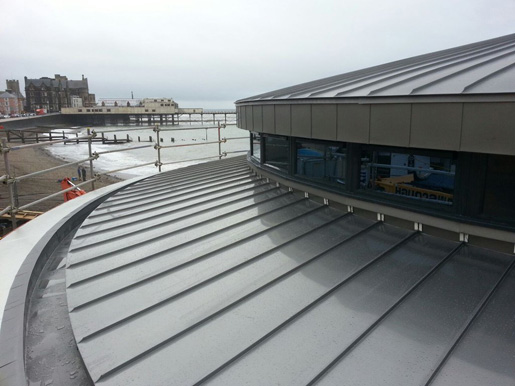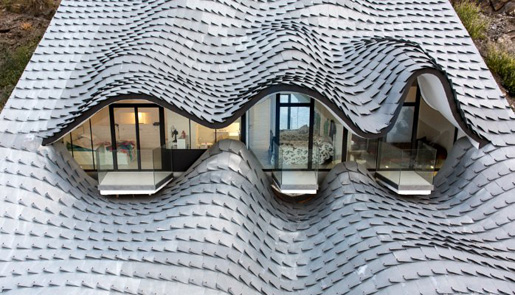Metal remains one of the most popular materials for roofs – but can you use it everywhere? Some of the buildings that best suit a metal roof and the crisp lines and functionality it provides are on the UK coastline. Just think about the minimalist lines, sweeping roofscapes and dynamic views for a moment. And then think about the severity of the weather.
You can use metals in a coastal environment, but you do need to use the right product.
The villain in this story is salt. Salt is the dark force within nature – it erodes and almost eats some substances, given enough time and exposure. On the coast the air carries water vapour that contains significant amounts of salt, which can attack and stain our cars, gutters and exposed metal surfaces, including metal roofing.

Kingsley Roofing have just completed this Aberystwyth Bandstand Roof in Nedzink
Metal Roofing on the Coast – the Headlines
- Some metals such as aluminium and coated steels are not suitable for coastal use because they are susceptible attack.
- Some metals such as copper and stainless steel are more resilient and can be used in coastal conditions. For example, copper has a resilient non-ferrous patina in which any salt deposits sit and are unlikely to attack the metal.
- Zinc can also be used in coastal conditions, but the answer is more challenging – essentially: ‘it depends’. Whilst zinc is regularly used on buildings on the coast, it is important to consider coastal conditions in the design of the roof and the choice of product.
Zinc in Coastal Locations – The Issue
Zinc is susceptible to salt attack, if the salt remains on the roof surface for a length of time. If the salt-laden water vapour condenses onto cool surfaces, such as the open surface of a zinc roof, rain will wash off salt deposits quite frequently, and it won’t be a problem, as can be evidenced with many zinc roofs on the coasts.
However soffits and fascias will also attract salt deposits through condensation, and these won’t be washed off with rain. Even in this country we don’t get rain that falls upwards to wash soffits clean. As a result, zinc fascias and soffits can develop a build-up of salt deposits, which are ugly and potentially corrosive. Salt affected zinc roofing will look like white orange peel.
Zinc in Coastal Locations – What to do
So if you do want a zinc roof on your coastal property, get in touch for advice. Here are some outline points to consider.
- Don’t use Zinc on fascia and soffits in a coastal location – stick to the washed roof surfaces and use alternative metals or other materials for fascia and soffits.
- Don’t use Zinc on protected areas of a roof – for example where the zinc is sheltered by overhangs or a corner which will restrict rainfall. Vertical cladding under a soffit would also be a potential problem.
- Don’t use darker zinc colours in coastal areas where salt deposits may cause superficial staining which will be more noticeable. Consider using lighter finishes. This is also a good idea in any area with a large seagull population!
- If you are going to use Zinc on a fascia or soffit, use the right type of zinc. For example, elZinc Advanced is a coated zinc product which prevents salt deposits attacking the zinc. Unlike other coastal products, this is available in relatively small quantities so your roofer may find it cost effective for small and medium sized projects.
Using metal roofing on the coast does work – but don’t take it for granted. Contact our team for advice before you make a commitment.
About the author – SIG Zinc and Copper Team
We are the team at SIG Zinc & Copper. We design and supply zinc, copper, aluminium and stainless steel roofing and cladding products all over the UK. We also publish blog posts! We're part of SIG Roofing. With over 120 branches nationwide, SIG Roofing is the largest supplier of roofing materials in the UK, providing our customers with impartial advice on the right roofing solution for their projects.








Recent Comments